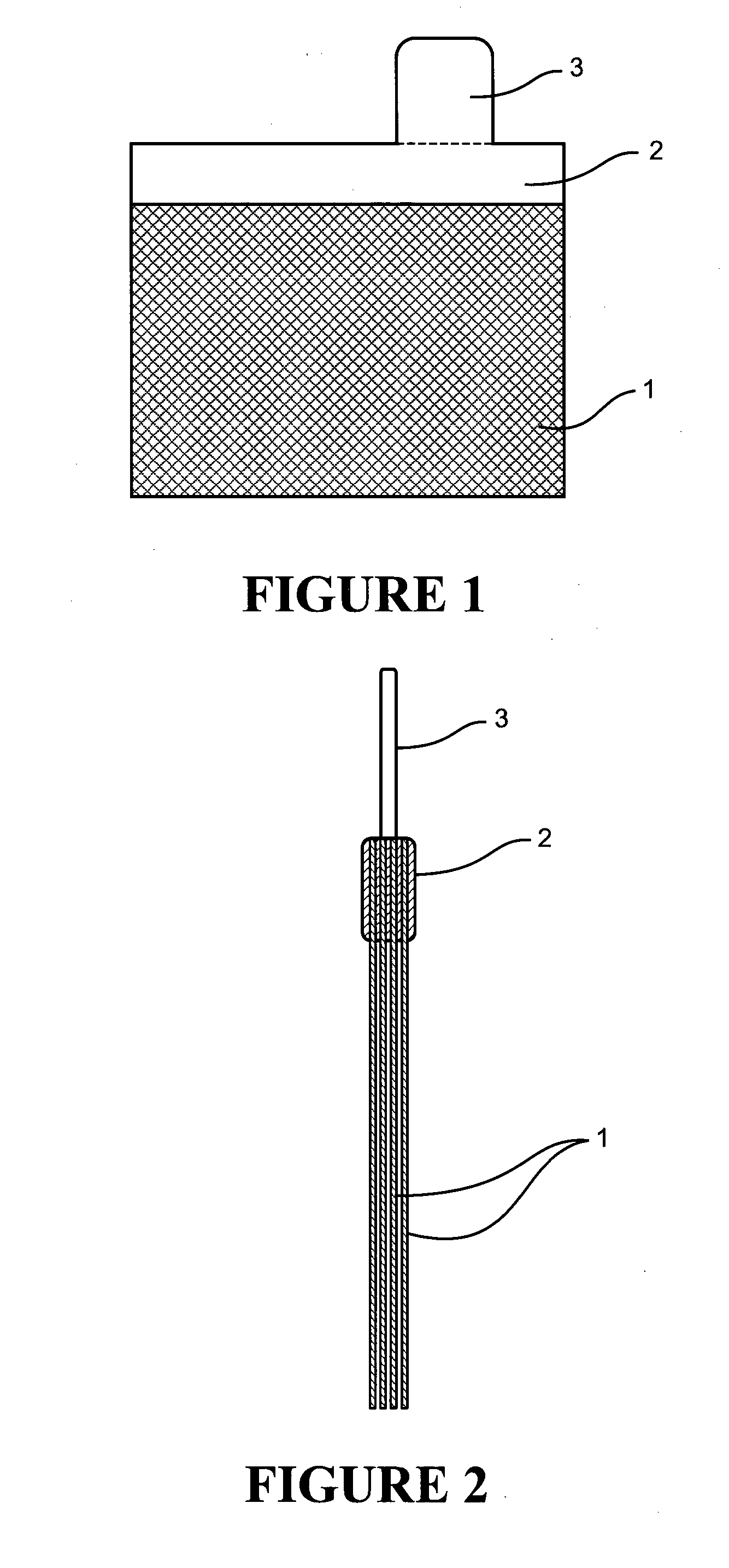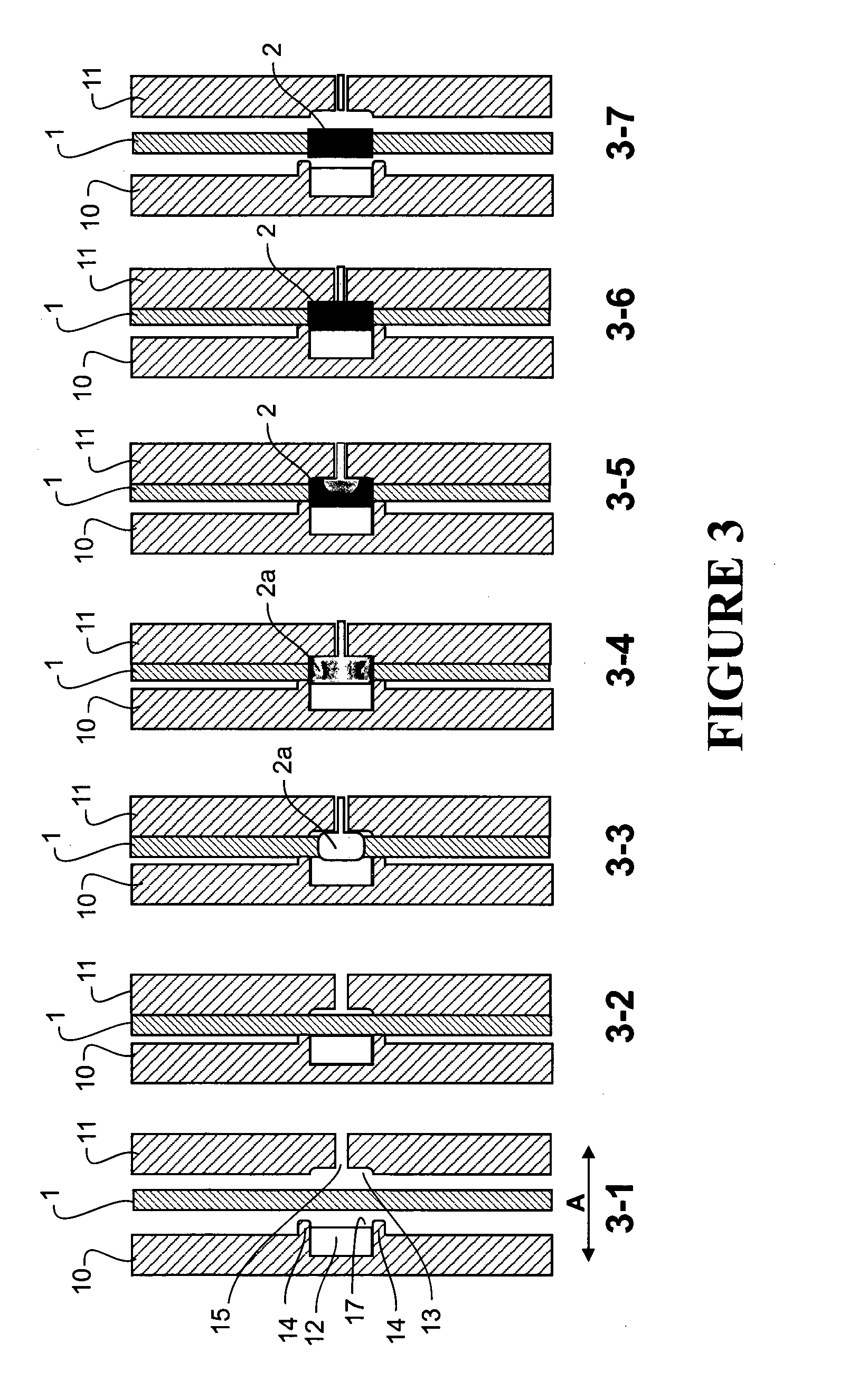Method for Forming an Electrical Connection to a Conductive Fibre Electrode and Electrode So Formed
- Summary
- Abstract
- Description
- Claims
- Application Information
AI Technical Summary
Benefits of technology
Problems solved by technology
Method used
Image
Examples
example 1
Lug Formation
[0126]In experimental work Pb lugs were formed on carbon fibre material generally by the method described above with reference to FIG. 5.
[0127]To obtain Scanning Electron Microscope (SEM) images of the insides of the lug region, the lugs were dipped in liquid Nitrogen and cleaved post formation. FIGS. 6A and 6B are a set of SEM images from a lug on a woven material with lead injected at a pressure of 10 bar. FIGS. 7A and 7B are another set of SEM images from a lug on a felted material with lead injected again at a pressure of 10 bar. Similarly FIGS. 8A and 8B are a set of SEM images from a lug on woven material with lead injected at a pressure of 10 bar with an epoxy applied to the top of the lug. FIGS. 6B, 7B, and 8B are at higher magnification than FIGS. 6A, 7A, and 8A. In all of FIGS. 6A, 6B, 7A, 7B, 8A and 8B the pale grey material is the lead and the long fibres are carbon fibres. The highest lead penetration of the material was achieved with a carbon felt material...
example 2
Lug Formation
[0129]The following two samples of lugs were attached to carbon felt by edge impregnation of molten lead in the major plane of the felt generally by the method described above with reference to FIG. 15.
[0130]The first sample was on carbon felt from Heilong Jiang in China with solid volume fraction 7.2%, thickness 1.5 mm and mean diameter of fibres 13.9 μm and arc treated as described above. This lug was made of two regions that lay next to each other—first a strip of lead in a cavity along the edge of the felt and second a lead matrix around the carbon fibres of the felt at its edge. By cutting off the second area and carefully measuring its dimensions and mass, together with determining the mass of a measured area of the felt, one can calculate the voidage fraction within the matrix (see below). This voidage was 22.5%. The resistivity of the matrix was also determined by resistance measurement with a resistance meter over a measured volume of the matrix. This resistivi...
example 3
Pb-Acid Cell CCA Performance with Electrode Comprising Lug
[0141]Electrode & Cell Construction:
[0142]An electrode was constructed from arc-treated carbon fibre felt having a specific weight of 238 g / m2, a thickness of 2.93 mm, and a carbon volume fraction ˜5.8%. After arc-treatment the felt had a specific weight of 204 g / m2, was 2.5 mm thick, and had a carbon volume fraction ˜5.7%. The carbon felt section was rectangular in shape and had previously had a Pb lug formed along one edge by edge impregnation of molten lead in the major plane of the felt generally by the method described above with reference to FIG. 15, so that Pb material of the lug penetrated fully through the lug zone of the carbon felt material from one side to the other.
[0143]Paste was prepared with 19.5 g of leady oxide having ˜5.1% Pb content, 3.36 g of diluted sulphuric acid, 2.24 g of Vanisperse A as an expander and water solution to achieve 0.10 wt % of expander in the prepared paste, and 0.16 g of Barium Sulphat...
PUM
| Property | Measurement | Unit |
|---|---|---|
| Fraction | aaaaa | aaaaa |
| Thickness | aaaaa | aaaaa |
| Thickness | aaaaa | aaaaa |
Abstract
Description
Claims
Application Information
 Login to View More
Login to View More - R&D
- Intellectual Property
- Life Sciences
- Materials
- Tech Scout
- Unparalleled Data Quality
- Higher Quality Content
- 60% Fewer Hallucinations
Browse by: Latest US Patents, China's latest patents, Technical Efficacy Thesaurus, Application Domain, Technology Topic, Popular Technical Reports.
© 2025 PatSnap. All rights reserved.Legal|Privacy policy|Modern Slavery Act Transparency Statement|Sitemap|About US| Contact US: help@patsnap.com



